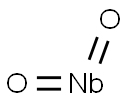Niobium oxide
Synonym(s):Niobium pentoxide
- CAS NO.:1313-96-8
- Empirical Formula: Nb2O5
- Molecular Weight: 265.81
- MDL number: MFCD00011128
- EINECS: 215-213-6
- SAFETY DATA SHEET (SDS)
- Update Date: 2025-12-17 09:49:47

What is Niobium oxide ?
Chemical properties
Niobium(V) oxide is a white crystalline powder and turns into light yellow when meeting oxygen. Insoluble in water, insoluble in acid, soluble in molten potassium hydrogen sulfate or alkali metal carbonate and hydroxide.
Physical properties
White orthogonal crystals; density 4.60 g/cm3; melts at 1,512°C; insoluble in water; soluble in hydrofluoric acid.
The Uses of Niobium oxide
Niobium(V) oxide is the precursor to a majority of niobium compounds, powder metallurgy products and alloys. It is also used in glass, optic and ceramic applications. The nanoparticles of niobium pentoxide are useful in the preparation of electrochemical capacitors and cathodes. In addition, appropriate preparations of this compound can be used as a dietary supplement in the food industry. It is a precursor to lithium niobate which finds extensive use in piezoelectric sensors, anti-aliasing filters, optical waveguides, mobile phones, surface acoustic devices, optical modulators including linear and non-linear optical applications.
What are the applications of Application
Niobium(V) oxide is an alternative to lithium metal in advanced fuel cells
Preparation
Niobium pentoxide is produced as an intermediate during recovery of Nb metal from ores (See niobium).
Also, the pentoxide may be produced by igniting niobium metal powder, niobium carbide, or niobium fluoride in oxygen.
What are the applications of Application
Niobium(V) oxide is used in metallurgy, electronics, optics, and the production of hard materials.
Applied in the solid state formation of an unusual cation deficient perovskite, Ba7Nb4MoO20.
Promising results were obtained using niobium(V) oxide as an alternate electrode to lithium metal in advanced fuel cells.
Niobium Oxide (Nb2O5) is a new electrode material with pseudocapacitive charge storage being introduced to the market for the first time as a potential anode material.
Health Hazard
Niobium pentoxide (Nb2O5) increases both the refractive index of optical glasses and the capacity of multi-layered ceramic capacitors (MLCCs). In contrast to lead oxide, niobium pentoxide poses no health risks.
Flammability and Explosibility
Non flammable
Properties of Niobium oxide
| Melting point: | 1520 °C |
| Density | 4.47 g/mL at 25 °C(lit.) |
| solubility | insoluble in H2O; soluble in HF |
| form | Powder |
| color | White to off-white |
| Specific Gravity | 4.6 |
| Resistivity | 5.5 ∞ 10*12 (ρ/μΩ.cm) |
| Water Solubility | insoluble |
| Crystal Structure | Trigonal |
| Merck | 14,6559 |
| Stability: | Stable. |
| CAS DataBase Reference | 1313-96-8(CAS DataBase Reference) |
| NIST Chemistry Reference | Diniobium pentaoxide(1313-96-8) |
| EPA Substance Registry System | Niobium oxide (Nb2O5) (1313-96-8) |
Safety information for Niobium oxide
| Signal word | Warning |
| Pictogram(s) |
 Exclamation Mark Irritant GHS07 |
| GHS Hazard Statements |
H315:Skin corrosion/irritation H319:Serious eye damage/eye irritation H335:Specific target organ toxicity, single exposure;Respiratory tract irritation |
| Precautionary Statement Codes |
P261:Avoid breathing dust/fume/gas/mist/vapours/spray. P304+P340:IF INHALED: Remove victim to fresh air and Keep at rest in a position comfortable for breathing. P305+P351+P338:IF IN EYES: Rinse cautiously with water for several minutes. Remove contact lenses, if present and easy to do. Continuerinsing. P405:Store locked up. |
Computed Descriptors for Niobium oxide
| InChIKey | ZKATWMILCYLAPD-UHFFFAOYSA-N |
Niobium oxide manufacturer
New Products
4,4-Difluoropiperidine hydrochloride tert-butyl 9-methoxy-3-azaspiro[5.5]undecane-3-carboxylate Indole Methyl Resin N-Isopropylurea N,N-Dicyclohexylcarbodiimide(DCC) MELDRUMS ACID 5-METHYLISOXAZOLE-4-CARBOXYLIC ACID Magnessium Bis glycinate Zinc ascorbate 1-bromo-2-butyne 2-acetamidophenol 9(10H)-anthracenone Erythrosin B, 4-Piperidinopiperidine 2-((4-morpholinophenylamino) (methylthio) methylene) malononitrile 2,4-dihydroxybenzaldehyde 3-(4-morpholinophenylamino)-5-amino-1H-pyrazole-4-carbonitrile Methyl 2-methylquinoline-6-carboxylate 2,6-dichloro-4-nitropyridine 4-Bromo-2-chlorobenzonitrile 2-(benzylamino)acetic acid hydrochloride 4-(tert-Butoxycarbonylamino)but- 2-ynoic acid 3,4-dihydro-2H-benzo[b][1,4]dioxepine 1-Phenyl-1-cycloprppanecarboxylicacidRelated products of tetrahydrofuran








You may like
-
 Niobium(V) oxide CAS 1313-96-8View Details
Niobium(V) oxide CAS 1313-96-8View Details
1313-96-8 -
 Niobium(V) oxide CAS 1313-96-8View Details
Niobium(V) oxide CAS 1313-96-8View Details
1313-96-8 -
 Niobium(V) oxide CAS 1313-96-8View Details
Niobium(V) oxide CAS 1313-96-8View Details
1313-96-8 -
 Niobium(V) oxide CAS 1313-96-8View Details
Niobium(V) oxide CAS 1313-96-8View Details
1313-96-8 -
 Niobium(V) oxide CAS 1313-96-8View Details
Niobium(V) oxide CAS 1313-96-8View Details
1313-96-8 -
 Niobium(V) oxide CAS 1313-96-8View Details
Niobium(V) oxide CAS 1313-96-8View Details
1313-96-8 -
 Niobium(V) oxide CAS 1313-96-8View Details
Niobium(V) oxide CAS 1313-96-8View Details
1313-96-8 -
 Niobium(V) oxide sputtering target, 50.8mm (2.0 in.) dia. x 3.18mm (0.125 in.) thick CASView Details
Niobium(V) oxide sputtering target, 50.8mm (2.0 in.) dia. x 3.18mm (0.125 in.) thick CASView Details
